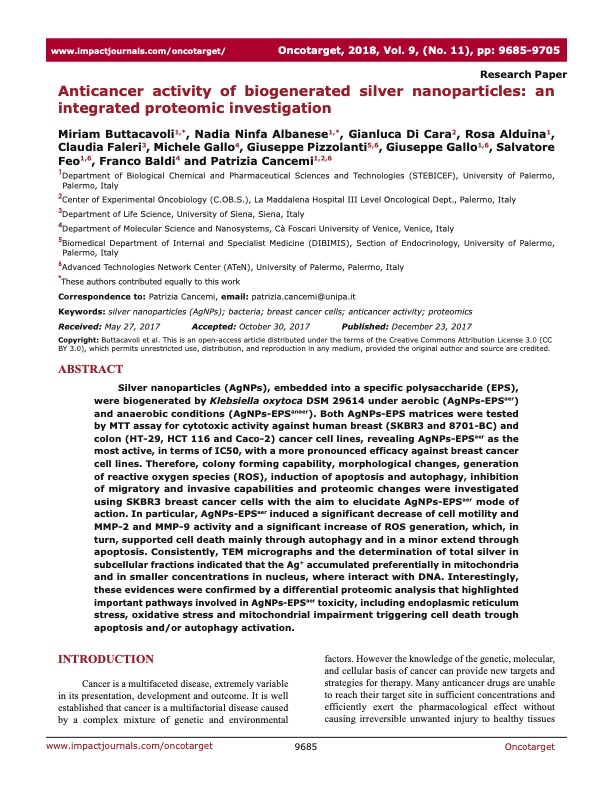
PDF Publication Title:
Text from PDF Page: 001
www.impactjournals.com/oncotarget/ Oncotarget, 2018, Vol. 9, (No. 11), pp: 9685-9705 Research Paper Anticancer activity of biogenerated silver nanoparticles: an integrated proteomic investigation Miriam Buttacavoli1,*, Nadia Ninfa Albanese1,*, Gianluca Di Cara2, Rosa Alduina1, Claudia Faleri3, Michele Gallo4, Giuseppe Pizzolanti5,6, Giuseppe Gallo1,6, Salvatore Feo1,6, Franco Baldi4 and Patrizia Cancemi1,2,6 1Department of Biological Chemical and Pharmaceutical Sciences and Technologies (STEBICEF), University of Palermo, Palermo, Italy 2Center of Experimental Oncobiology (C.OB.S.), La Maddalena Hospital III Level Oncological Dept., Palermo, Italy 3Department of Life Science, University of Siena, Siena, Italy 4Department of Molecular Science and Nanosystems, Cà Foscari University of Venice, Venice, Italy 5Biomedical Department of Internal and Specialist Medicine (DIBIMIS), Section of Endocrinology, University of Palermo, Palermo, Italy 6Advanced Technologies Network Center (ATeN), University of Palermo, Palermo, Italy *These authors contributed equally to this work Correspondence to: Patrizia Cancemi, email: patrizia.cancemi@unipa.it Keywords: silver nanoparticles (AgNPs); bacteria; breast cancer cells; anticancer activity; proteomics Received: May 27, 2017 Accepted: October 30, 2017 Published: December 23, 2017 Copyright: Buttacavoli et al. This is an open-access article distributed under the terms of the Creative Commons Attribution License 3.0 (CC BY 3.0), which permits unrestricted use, distribution, and reproduction in any medium, provided the original author and source are credited. ABSTRACT Silver nanoparticles (AgNPs), embedded into a specific polysaccharide (EPS), were biogenerated by Klebsiella oxytoca DSM 29614 under aerobic (AgNPs-EPSaer) and anaerobic conditions (AgNPs-EPSanaer). Both AgNPs-EPS matrices were tested by MTT assay for cytotoxic activity against human breast (SKBR3 and 8701-BC) and colon (HT-29, HCT 116 and Caco-2) cancer cell lines, revealing AgNPs-EPSaer as the most active, in terms of IC50, with a more pronounced efficacy against breast cancer cell lines. Therefore, colony forming capability, morphological changes, generation of reactive oxygen species (ROS), induction of apoptosis and autophagy, inhibition of migratory and invasive capabilities and proteomic changes were investigated using SKBR3 breast cancer cells with the aim to elucidate AgNPs-EPSaer mode of action. In particular, AgNPs-EPSaer induced a significant decrease of cell motility and MMP-2 and MMP-9 activity and a significant increase of ROS generation, which, in turn, supported cell death mainly through autophagy and in a minor extend through apoptosis. Consistently, TEM micrographs and the determination of total silver in subcellular fractions indicated that the Ag+ accumulated preferentially in mitochondria and in smaller concentrations in nucleus, where interact with DNA. Interestingly, these evidences were confirmed by a differential proteomic analysis that highlighted important pathways involved in AgNPs-EPSaer toxicity, including endoplasmic reticulum stress, oxidative stress and mitochondrial impairment triggering cell death trough apoptosis and/or autophagy activation. INTRODUCTION Cancer is a multifaceted disease, extremely variable in its presentation, development and outcome. It is well established that cancer is a multifactorial disease caused by a complex mixture of genetic and environmental factors. However the knowledge of the genetic, molecular, and cellular basis of cancer can provide new targets and strategies for therapy. Many anticancer drugs are unable to reach their target site in sufficient concentrations and efficiently exert the pharmacological effect without causing irreversible unwanted injury to healthy tissues www.impactjournals.com/oncotarget 9685 OncotargetPDF Image | Anticancer activity of biogenerated silver nanoparticles

PDF Search Title:
Anticancer activity of biogenerated silver nanoparticlesOriginal File Name Searched:
oncotarget-09-9685.pdfDIY PDF Search: Google It | Yahoo | Bing
Turbine and System Plans CAD CAM: Special for this month, any plans are $10,000 for complete Cad/Cam blueprints. License is for one build. Try before you buy a production license. More Info
Waste Heat Power Technology: Organic Rankine Cycle uses waste heat to make electricity, shaft horsepower and cooling. More Info
All Turbine and System Products: Infinity Turbine ORD systems, turbine generator sets, build plans and more to use your waste heat from 30C to 100C. More Info
CO2 Phase Change Demonstrator: CO2 goes supercritical at 30 C. This is a experimental platform which you can use to demonstrate phase change with low heat. Includes integration area for small CO2 turbine, static generator, and more. This can also be used for a GTL Gas to Liquids experimental platform. More Info
Introducing the Infinity Turbine Products Infinity Turbine develops and builds systems for making power from waste heat. It also is working on innovative strategies for storing, making, and deploying energy. More Info
Need Strategy? Use our Consulting and analyst services Infinity Turbine LLC is pleased to announce its consulting and analyst services. We have worked in the renewable energy industry as a researcher, developing sales and markets, along with may inventions and innovations. More Info
Made in USA with Global Energy Millennial Web Engine These pages were made with the Global Energy Web PDF Engine using Filemaker (Claris) software.
Infinity Turbine Developing Spinning Disc Reactor SDR or Spinning Disc Reactors reduce processing time for liquid production of Silver Nanoparticles.
| CONTACT TEL: 608-238-6001 Email: greg@infinityturbine.com | RSS | AMP |